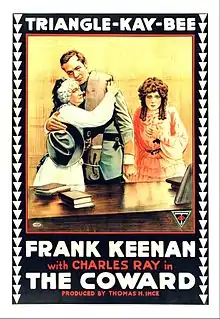The Coward (1915 film)
The Coward is a 1915 American silent historical war drama film directed by Reginald Barker and produced by Thomas H. Ince. Ince also wrote the film's scenario with C. Gardner Sullivan, from a story Ince had bought from writer (and future director) Edward Sloman. The film stars Frank Keenan and Charles Ray.[2] John Gilbert also appears in an uncredited bit part.[3] A copy of The Coward is preserved at the Museum of Modern Art.[4]
| The Coward | |
|---|---|
 Film poster. | |
| Directed by | Reginald Barker |
| Produced by | Thomas H. Ince |
| Screenplay by | Thomas H. Ince C. Gardner Sullivan |
| Story by | Edward Sloman Thomas H. Ince |
| Starring | Charles Ray Frank Keenan Gertrude Claire Margaret Gibson |
| Cinematography | Joseph H. August Robert S. Newhard |
Production company | |
| Distributed by | Triangle Kay-Bee Enterprise Distributing Corporation (re-release) |
Release date |
|
Running time | 77 minutes |
| Country | United States |
| Language | Silent English intertitles |
| Budget | $17,922[1] |
.jpg.webp)
Synopsis
Set during the American Civil War, Keenan stars as a Virginia colonel, with Charles Ray as his weak-willed son. The son is forced, at gunpoint, by his father to enlist in the Confederate States Army. He is terrified by the war and deserts during a battle. The film focuses on the son's struggle to overcome his cowardice.
Cast
- Frank Keenan as Col. Jefferson Beverly Winslow
- Charles Ray as Frank Winslow
- Gertrude Claire as Mrs. Elizabeth Winslow
- Nick Cogley as a Negro Servant
- Charles K. French as a Confederate Commander
- Margaret Gibson as Amy
- Minnie Provost as Mammy
- John Gilbert as a Young Virginian (uncredited)
- Bob Kortman as a Union Officer (uncredited)
- Leo Willis as a Union Soldier (uncredited)
Reception
The Coward was both a critical and financial success and helped to launch Charles Ray's career.[3]
Criticism
Unusual for films of this period, the main character is not presented as a gallant Southerner who is eager to fight in the war.[5] However, consistent with practice when the film was made, black characters were played by non-black actors in blackface. Another 1915 film, The Birth of a Nation, used whites in blackface to represent all of its major black characters,[6] but reaction against that film's racism largely put an end to this practice in dramatic film roles, although blackface continued to be used in comedies.[7]
The acting in the film has also been noted to have been much more naturalistic than had been common in prior silent films, with cutting and camera angles aiding the actor's use of facial expressions and pauses to convey dramatic tension.[8]
References
- Taves, Brian (2012). Thomas Ince: Hollywood's Independent Pioneer. University Press of Kentucky. p. 101. ISBN 978-0-813-13422-2.
- Langman, Larry; Ebner, David, eds. (2001). Hollywood's Image Of the South: A Century Of Southern Films. Greenwood Publishing Group. p. 23. ISBN 0-313-31886-7.
- Golden, Eve (2013). John Gilbert: The Last of the Silent Film Stars. University Press of Kentucky. pp. 24–25. ISBN 978-0-813-14163-3.
- The Coward at silentera.com
- Campbell, Jr., Edward D. C. (1981). The Celluloid South: Hollywood and the Southern Myth. University of Tennessee Press. pp. 62–63. ISBN 0-87049-327-2.
- Strausbaugh, John (2006). Black Like You: Blackface, Whiteface, Insult and Imitation in American Popular Culture. Jeremy P. Tarcher / Penguin. pp. 211–12, 214. ISBN 1-58542-498-6.
- Rogin, Michael (1998). Blackface, White Noise: Jewish Immigrants in the Hollywood Melting Pot. University of California Press. p. 79. ISBN 0-520-21380-7.
- Bowser, Eileen (1994). The Transformation of Cinema. University of California Press. p. 57. ISBN 0-520-08534-5.
External links
- The Coward at AllMovie
- The Coward at IMDb